|
|
|||
|---|---|---|---|
Branches (Nozzles) |
|||
| HIGH-RISE Fire Fighting |
|||
| Developing better responses to fires in tower bocks and high-rise buildings | |||
Selection of branches is a function of its end use in the high-rise environment. Its primary function must be related to FLOW RATE. It is flow rate this that will ultimately extinguish the potentially high energy (wind driven) fires in tall buildings.
Nozzles may be divided into 3 groups.
Smooth Bore (Solid jet)
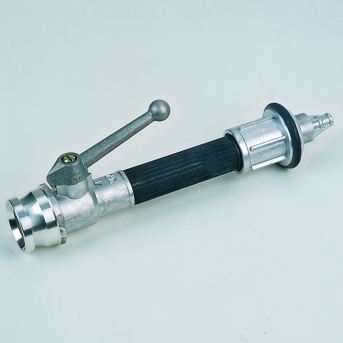 |
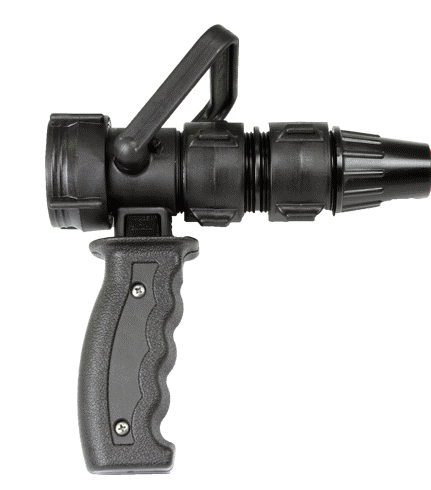 |
These Branches produce a solid, uniform and continuous jet of water throughout its working range. They can have a variety of nozzle output sizes (diameter) and have excellent throw and flow characteristics. They are also able to produce high levels of "jet reaction" making these jets harder to use.
Multipurpose (Combination)
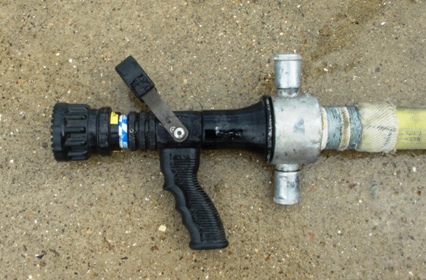
These are capable of producing a range of outlet patterns ranging from a (close approximation of a) solid stream up to wider cone spray patterns and fog. Spray patterns minimise "jet reaction" but will reduce "throw". Spray and fog patterns are important when using 3D-Gas cooling fire fighting techniques.
Specialised Branches
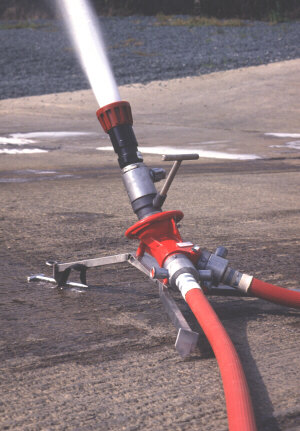
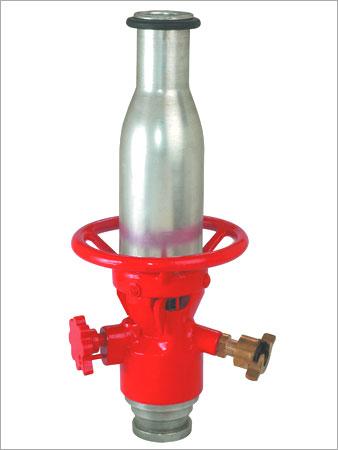
These may be many and varied and include foam making, basement branches, fixed and mobile monitor and high pressure cutting lances Most modern branches have some form of hand control systems that enable control of flow rate and (if appropriate) spray pattern. In common use in most UK FRS are multipurpose 'Automatic' branches. These tend to use a spring controlled valve/orifice plate to regulate and control a steady discharge pressure. These branches work well within their specified input pressure ranges, but care must be taken when the branch input pressure falls below the effective performance limits. Discharge flow rate can be observed to fall drastically with these lower pressures. Real world empirical tests of these branches have occasionally shown a marked deviance from manufactures specification. This may be down to wear or servicing issues, but branches should be trialed and selected on actual performance as well as its expected design criteria.
In the High Rise enviroment.
The very nature of the most commonly found fixed installations in high-rise buildings, namely 4” (100mm) Dry risers, will limit water supply. Added to this the additional requirement to pump water to a great height (head), the potential pressure and supply at any given dry riser outlet will already be limited. Add to this the common use of 45mm hose lines, it is imperative that branches be specified that can deliver an optimum flow rate at lower pressures.
There are a range of potential Intervention (fire fighting and rescue) tactics in High-Rise buildings. These range from a single hose line rapid intervention (likely in a commercial/retail building) up to a 3 line full intervention with backup and safety jets in place.
The original British Standard design specification for dry risers would provision 3x 445 l/p jets. This specification was written when “A” type smooth bore branches were in common use through all FRS. Conventionally they had 19mm nozzles and would provide an unrestricted, uncontrolled flow consisting of a solid jet.
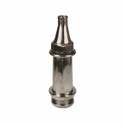 UK "A" Type Branch
UK "A" Type Branch
As fire-fighting techniques evolved, combination jet /spray branches became the norm and most FRS discarded smooth bore branches completely. As 3D fGas cooling fighting techniques were developed together with Flashover and Back draft (compartment) training the need for high quality, consistent sprays became more important. It may be argued that some UK FRS lost sight of the requirement for branches to be also able to flow reasonable amounts of water. This was even further compounded with the introduction of “automatic” branches that would control the spray pattern and delivery, usually at the detriment of the flow. Fire-fighters need to be provisioned with a selection of hand controlled branches (or if possible one branch) that can provide very high flow, even at low input pressure, and variable spray patterns.
Conventionally an effective fire-fighting jet, for entry into a compartment fire may be rated with a MINIMUM flow rate of 350L/m.
In the environment where a higher energy fire may be suspected. A more suitable flow rate would be
Branch manufactures are starting to produce combination and constant flow (spray/jet) low pressure, high flow branches that are more suited to the constraints imposed by high rise buildings.
In general the best performing branches will be smooth bore as they provide virtually no resistance to the water stream and subsequently high output rates (l/m) even at very low pressures (2.5-3 bar).
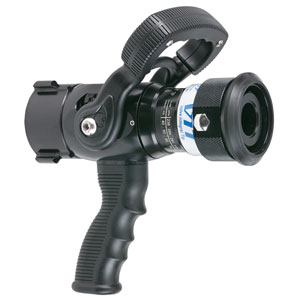
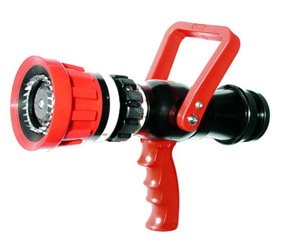 A modern Smoothbore, hand
A modern Smoothbore, hand
controlled Branch (TFT)
A low pressure/ high flow
combination branch (Delta)
A well balanced attack may consist of 2 hose lines, one terminating in a smooth bore branch (19-22mm) and a suitable low pressure/high flow combination branch. With this combination, modern compartment fire-fighting techniques and, perhaps “old fashion” high flow solid jets, can be used together or in isolation to provide the best attack of the fire.. Whenever possible these should be backed up with suitable safety/covering jets.